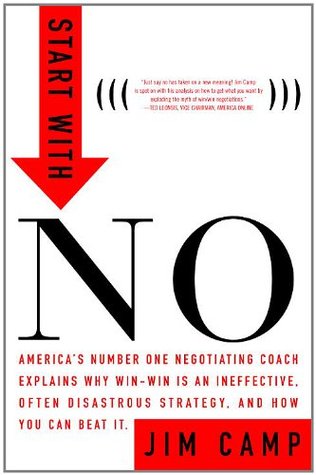More on this book
Community
Kindle Notes & Highlights
by
Jim Camp
Read between
September 13 - October 30, 2017
Be Sure You Know the Real Decision Makers
As a rule, the bigger the organization the more complex and confusing the decision-making process can be.
“Of course you make the decisions. But who else might you want to talk with?” “Who might be of service in making this decision?” “Who should we invite to support your decision?” “Who’d be sorry or upset if we left them out?” “How will this decision be reached?” “When will it be reached?” “What criteria and paperwork must be in place for it to be reached?”
It Never Hurts to Start at the Top You can get around your basic blocker in several ways. A surefire way is simply to start at the top. What happens if you start at the top?
Every negotiating session—even a telephone call or an e-mail, no matter how short, even one minute or one paragraph—requires an agenda. Maybe this sounds radical at first, but it’s really not. Every call and e-mail has some kind of purpose, doesn’t it? I hope so. So what’s the purpose?
A valid agenda or mini-agenda has five basic categories: 1. Problems 2. Our baggage 3. Their baggage 4. What we want 5. What happens next
“George, I’m new in this business. If my inexperience is going to be a problem in this deal, let’s talk about it now.” “Yes, now’s a good time. John, the only problem I have with your being new is that if we come up against something you can’t handle with confidence, I want your assurance that you’ll call in someone to help. Someone who really knows how to handle that problem. If that’s okay with you, I’m comfortable.” “That’s fine with me. Are you sure it’s okay with you?” “Yes, John. It’s okay with me.” “All right, that will be our deal. If I can’t handle something with complete confidence,
...more
Often negotiators don’t know what they want—not really—not step by step by step by step down the long and winding road. They just want a signed deal, that’s all. They don’t have a clue about what they want at every step of the decision-making process along the way. They’re thinking about ends, which are out of their control, not about means, which we control with agendas.
If you have worked effectively to paint the pain, a presentation is simply a waste of time and energy. If you have not painted the pain, the presentation is no substitute for your failure to do so, and it won’t do you any good now.
Most recruits make the mistake of submitting film that is in their own world: clips of their spectacular runs, spectacular catches, touchdowns. But is this what the coach really wants to see? If it’s not, if the coach’s pain is elsewhere, the recruit has not presented to that pain. The way to find out is to ask the question this recruit asked of every coach: “How do you evaluate a player?” Isn’t this question just common sense? Yes. But is it commonly asked? No.
What is prep-end step? It’s the reminder that your work in this negotiating session isn’t over until you’ve either prepared the bridge to the next one by means of “what happens next” on the agenda,
Prep-end step is also about how to end the negotiation short of agreement. It happens in straight sales, it happens in proposed multibillion-dollar corporate mergers. You have a budget for the negotiation, you have your mission and purpose, and this deal just isn’t going to happen. This finally becomes clear. You decide the time has come to retire. When this happens, I recommend the calm, quiet “Thanks but no thanks, maybe next time.” To my mind, this fadeaway is far more effective than burning bridges. I hate to see clients burn their bridges, no matter how ill-served they feel.
In this world, you must “pay forward” because you can’t really pay others back, not sufficiently.
Achievement requires self-esteem, and to build self-esteem you only need to start paying forward, to pay forward more effectively, at every opportunity, with your family and friends, in the workplace, in your community, in your house of worship, everywhere.


